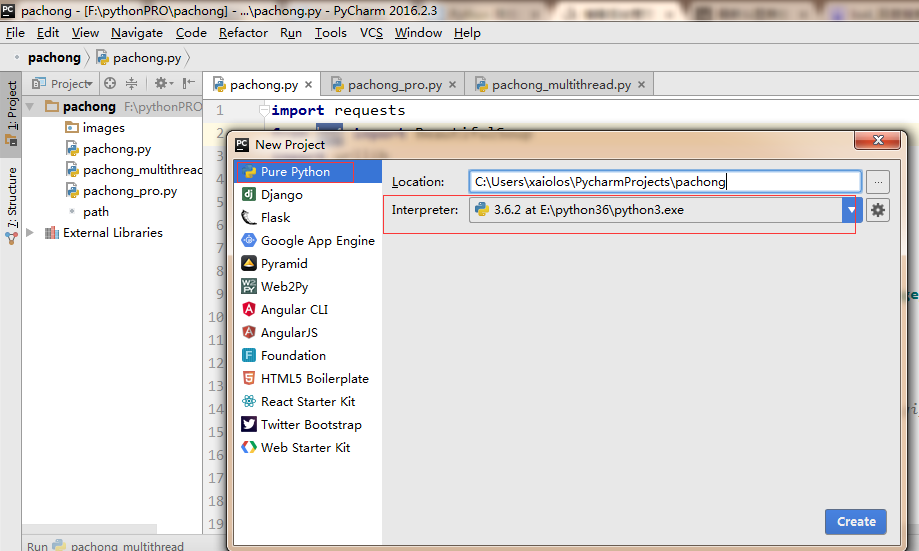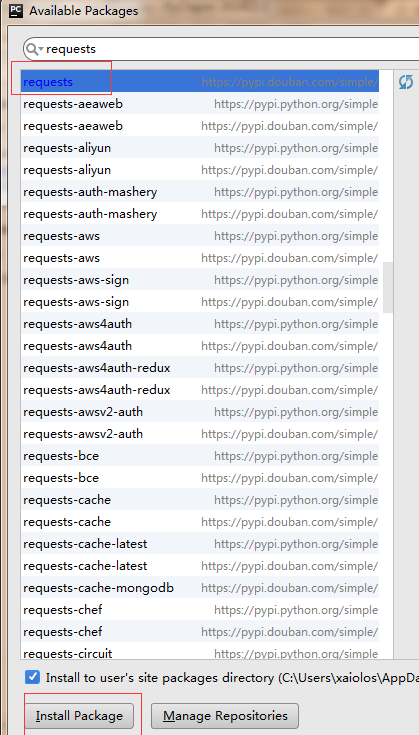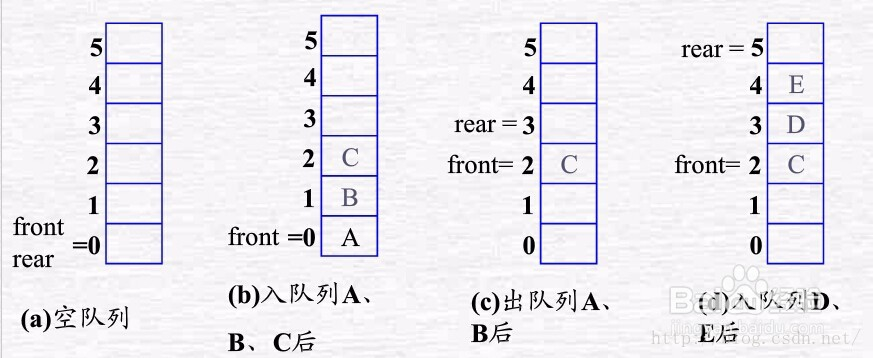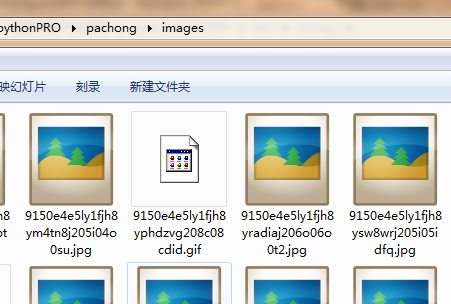大家都知道python经常被用来做爬虫,用来在互联网上抓取我们需要的信息。
使用Python做爬虫,需要用到一些包:
requests
urllib
BeautifulSoup
等等,关于python工具的说明,请看这里:Python 爬虫的工具列表
今天介绍一个简单的爬虫,网络聊天流行斗图,偶然发现一个网站www.doutula.com.上面的图片挺搞笑的,可以摘下来使用。
我们来抓一下“最新斗图表情”:

看到下面有分页,分析下他的分页url格式:

不难发现分页的url是:https://www.doutula.com/photo/list/?page=x
一步步来:
先简单抓取第一页上的图片试试:
将抓取的图片重新命名,存储在项目根目录的images目录下:
分析网页上img格式:

好了,我们开始准备写程序吧:使用pycharm IDE创建项目

我们抓包会用到:requests 和urllib,需要先安装这些包:file->default settings

点击右侧绿色的+号:

同样的引入:BeautifulSoup,lxml
接下来就可以引入这些包,然后开始开发了:

import requests from bs4 import BeautifulSoup import urllib import os url = 'https://www.doutula.com/photo/list/?page=1' response = requests.get(url) soup = BeautifulSoup(response.content,'lxml') img_list = soup.find_all('img',attrs={'class':'img-responsive lazy image_dta'}) i=0 for img in img_list: print (img['data-original']) src = img['data-original'] #src = '//ws1.sinaimg.cn/bmiddle/9150e4e5ly1fjlv8kgzr0g20ae08j74p.gif' if not src.startswith('http'): src= 'http:'+src filename = src.split('/').pop() fileextra = filename.split('.').pop() filestring = i+'.'+fileextra path = os.path.join('images',filestring) # 下载图片 headers = { 'Accept': 'text/html,application/xhtml+xml,application/xml;q=0.9,image/webp,*/*;q=0.8', 'Accept-Encoding': 'gzip, deflate, sdch', 'Accept-Language': 'zh-CN,zh;q=0.8', 'Connection': 'keep-alive', 'User-Agent': 'Mozilla/5.0 (Windows NT 6.3; WOW64) AppleWebKit/537.36 (KHTML, like Gecko) Chrome/43.0.235' } #urllib.request.urlretrieve(url,path,header) req = urllib.request.Request(url=src, headers=headers) cont = urllib.request.urlopen(req).read() root = r""+path+"" f=open(root,'wb') f.write(cont) f.close i += 1
注意:
1.请求的时候需要加上header,伪装成浏览器请求,网站大多不允许抓取。
抓完一页的图片,我们试着抓取多页的图片:这里试下抓取第一页和第二页的图片

import requests from bs4 import BeautifulSoup import urllib import os import datetime #begin print (datetime.datetime.now()) URL_LIST = [] base_url = 'https://www.doutula.com/photo/list/?page=' for x in range(1,3): url = base_url+str(x) URL_LIST.append(url) i = 0 for page_url in URL_LIST: response = requests.get(page_url) soup = BeautifulSoup(response.content,'lxml') img_list = soup.find_all('img',attrs={'class':'img-responsive lazy image_dta'}) for img in img_list: #一页上的图片 print (img['data-original']) src = img['data-original'] if not src.startswith('http'): src= 'http:'+src filename = src.split('/').pop() fileextra = filename.split('.').pop() filestring = str(i)+'.'+fileextra path = os.path.join('images',filestring) # 下载图片 headers = { 'Accept': 'text/html,application/xhtml+xml,application/xml;q=0.9,image/webp,*/*;q=0.8', 'Accept-Encoding': 'gzip, deflate, sdch', 'Accept-Language': 'zh-CN,zh;q=0.8', 'Connection': 'keep-alive', 'User-Agent': 'Mozilla/5.0 (Windows NT 6.3; WOW64) AppleWebKit/537.36 (KHTML, like Gecko) Chrome/43.0.235' } #urllib.request.urlretrieve(url,path,header) req = urllib.request.Request(url=src, headers=headers) cont = urllib.request.urlopen(req).read() root = r""+path+"" f=open(root,'wb') f.write(cont) f.close i += 1 #end print (datetime.datetime.now())
这样我们就完成了多页图片的抓取,但是貌似有点慢啊,要是抓所有的,那估计得花一点时间了。
python是支持多线程的,我们可以利用多线程来提高速度:
分析一下这是怎么样的一个任务:我们将网页地址全部存储到一个list中,所有的图片地址也存储在一个list中,然后按顺序来取图片地址,再依次下载
这样类似一个:多线程有序操作的过程,就是“消费者生产者模式”,使用list加锁来实现队列(FIFO先进先出)。
一起回忆一下队列的特点吧:

看代码吧:我们下载第一页到第99页的图片

import requests from bs4 import BeautifulSoup import urllib import os import datetime import threading import time i = 0 FACE_URL_LIST = [] URL_LIST = [] base_url = 'https://www.doutula.com/photo/list/?page=' for x in range(1,100): url = base_url+str(x) URL_LIST.append(url) #初始化锁 gLock = threading.Lock() #生产者,负责从页面中提取表情图片的url class producer(threading.Thread): def run(self): while len(URL_LIST)>0: #访问时需要加锁 gLock.acquire() cur_url = URL_LIST.pop() #使用完后及时释放锁,方便其他线程使用 gLock.release() response = requests.get(cur_url) soup = BeautifulSoup(response.content, 'lxml') img_list = soup.find_all('img', attrs={'class': 'img-responsive lazy image_dta'}) gLock.acquire() for img in img_list: # 一页上的图片 print(img['data-original']) src = img['data-original'] if not src.startswith('http'): src = 'http:' + src FACE_URL_LIST.append(src) gLock.release() time.sleep(0.5) #消费者,负责从FACE_URL_LIST中取出url,下载图片 class consumer(threading.Thread): def run(self): global i j=0 print ('%s is running' % threading.current_thread) while True: #上锁 gLock.acquire() if len(FACE_URL_LIST) == 0: #释放锁 gLock.release() j = j + 1 if (j > 1): break continue else: #从FACE_URL_LIST中取出url,下载图片 face_url = FACE_URL_LIST.pop() gLock.release() filename = face_url.split('/').pop() fileextra = filename.split('.').pop() filestring = str(i) + '.' + fileextra path = os.path.join('images', filename) #path = os.path.join('images', filestring) # 下载图片 headers = { 'Accept': 'text/html,application/xhtml+xml,application/xml;q=0.9,image/webp,*/*;q=0.8', 'Accept-Encoding': 'gzip, deflate, sdch', 'Accept-Language': 'zh-CN,zh;q=0.8', 'Connection': 'keep-alive', 'User-Agent': 'Mozilla/5.0 (Windows NT 6.3; WOW64) AppleWebKit/537.36 (KHTML, like Gecko) Chrome/43.0.235' } # urllib.request.urlretrieve(url,path,header) req = urllib.request.Request(url=face_url, headers=headers) cont = urllib.request.urlopen(req).read() root = r"" + path + "" f = open(root, 'wb') f.write(cont) f.close print(i) i += 1 if __name__ == '__main__': #在本文件内运行 # begin print(datetime.datetime.now()) #2个生产者线程从页面抓取表情链接 for x in range(2): producer().start() #5个消费者线程从FACE_URL_LIST中提取下载链接,然后下载 for x in range(5): consumer().start() #end print (datetime.datetime.now())
看看images文件夹下多了好多图,以后斗图不用愁了!

OK,到此算是结束了。最后为python宣传一下。

